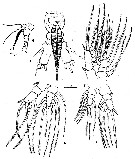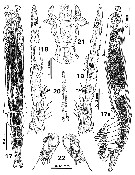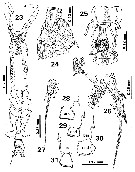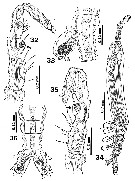|
|
 |
|
Monstrilloida ( Order ) |
|
|
|
Monstrillidae ( Family ) |
|
|
|
Monstrilla ( Genus ) |
|
|
| |
Monstrilla elongata Suarez-Morales, 1994 (F,M) | |
| | | | | | | Ref.: | | | Suarez-Morales, 1994 a (p.262, Descr. F, figs.F); Grygier, 1995 a (p.64); Suarez-Morales, 2000 b (p.685, Rem.); Suarez-Morales, 2001 b (p.21, Redescr.F,M, figs.F,M); 2011 (p.8, 10, Rem.); Suarez-Morales & Castellanos-Osorio, 2019 (p.120) |  issued from : E. Suarez-Morales in Proc. Biol. Soc. Washington, 1994, 107 (2). [p.263, Fig.1]. Female (from off Puerto Morelos, Yucatan): A-B, habitus (dorsal and lateral, respectively); C, right A1 (dorsal); D, left A1 (dorsal); E, forehead (dorsal); F, urosome (ventral); G, P5 (ventral view). Nota: Cephalic segment long and slender, almost 0.65 of total body length. Oral papilla located 0.43 of way back along cephalic segment. Eyes absent. A1 5-segmented (2-5 partially fused); ratio of length of 1st segment and remainder 14 : 86 = 100; A1 0.24 of total body length. Head and 1st pedigerous somite fused. P5 1-segmented with broad single lobe bearing 2 setae, outer seta slightly longer than inner. Urosome consisting of 5th pedigerous somite, genital double somite and 2 free abdominal somites; length ratio of these 4 segments 39.6 : 33.3 : 14.6 : 12.5 = 100.
|
 issued from : E. Suarez-Morales in Proc. Biol. Soc. Washington, 1994, 107 (2). [p.265, Fig.2]. Female: H, urosome (lateral); I, genital segment with ovigerous structures, and caudal rami (ventral); J, P2; K, P3; L, P1. Nota: Genital complex with annulated ovigerous structures. Caudal rami 2.3 times longer than wide, bearing 5 setae.
|
 issued from : E. Suarez-Morales in Proc. Biol. Soc. Washington, 1994, 107 (2). [p.264]. Female: Armement formula of swimming legs.
|
 issued from : E. Suarez-Morales in Ann. Inst. Biol. Univ. Nac. Aut. Mexico, ser. Zool., 2001, 72 (1). [p.19, Figs.17-22]. Female (from 18°34'07''N, 87°22'47''W): 17- 17a, habitus (dorsal and lateral, respectively; antennules cut short); 18, left A1 (dorsal; arrow showing middle ''haired'' basal plate); 19, right A1 (dorsal; arrow showing middle ''haired'' basal plate); 20, right A1 in proportio,n to figures 17 and 17a. anterior part of cephalothorax and head (ventral); 21, urosome (dorsal); 22, caudal rami (dorsal). Nota: - Cephalothorax (incorporating 1st pedigerous somite) accounting for 67.7% of total body length (caudal rami excluded). - Oral papilla located 0.40-0.43 of distance posteriorly along ventral surface of cephalothorax. - Nauplius eye and ocelli weakly developed, almost indistinguishable. - A1 relatively long, 0.24 of total body length, and 0.48 length of cephalothorax; 5-segmented, with segments 2-5 partially fused; two terminal spines forming pincer-like structure. - P5 short, with 1 lobe, basally separated, bearing 2 setae. - Urosome consisting of 5th pedigerous somite, genital double-somite, and 2 free abdominal somites. Urosome (excluding caudal rami) 15.4% of total body length. - Genital double-somite without intersegmental division; double-somite representing 35.7% of the length of urosome. - Ratios of length urosomal somites 35.7 : 35.7 : 15.1 : 12.5 = 100. - Short ovigerous spines, basally separated, swollen medially but slender distally. - Caudal rami about 2 times longer than wide, moderately divergent, bearing 1 outer, 3 terminal, and 1 dorsal setae; dorsal seta anout 2/3 length of ramus.
|
 issued from : E. Suarez-Morales in Ann. Inst. Biol. Univ. Nac. Aut. Mexico, ser. Zool., 2001, 72 (1). [p.22]. Female: Setae (Arabic numerals) and spines (Roman numerals) formula of swimming legs P1 to P4.
|
 issued from : E. Suarez-Morales in Ann. Inst. Biol. Univ. Nac. Aut. Mexico, ser. Zool., 2001, 72 (1). [p.20, Figs.23-31]. Male (from Banco Chinchorro): 23, habitus (ventral); 24, forhead and A1 bases (lateral); 25, genital complex (ventral); 26, right P4 (anterior) showing intercoxal sclerite and setation pattern; 27, terminal exopodal segment of P2; 28, 1st endopodal segment and basis of P1; 29, same of right P2; 30, same of P3; 31, same of left P2. Nota: - Cephalothorax accounting for 66% of total body length. - Forhead with pair of sensilla (visible most easily in lateral view). - ventral and dorsal surfaces of cephalothorax with vertical rows of small, blister-like processes reaching posterior margin of cephalothorax. - Oral papilla lying midventrally 0.23-0.37 of distance posteriorly along cephalothorax, not protuberant. - Nauplius and ocelli present, weakly developed. - A1 relatively long, slender, slightly longer than 53% of cephalothorax length, and about 35.5% of total body length; 5-segmented, with segments 3-4 fused. - P5 reduced, represented by pair of bud-like protuberances (visible in lateral view), armed with 1 seta each; seta reaching posterior margin of anal somite. - Genital complex formed by long, narrow-based globose shaft with 2 terminal lappets (figs.25 and 33); terminal lappets formed with a single distal pore located between them. - Urosiome consisting of 5 somites: 5th pedigerous somite, genital somite with genital complex, and 3 free abdominal somites, last one being the anal somite. Urosome (excluding caudal rami) relatively short, accounting for 12% of total body length. Ratios of lengths 29.0 : 25.8 : 17.1 : 16.2 : 11.8 = 100. Caudal rami subrectangular, about 1.5 times as long as wide, moderately divergent.Caudal ramus bearing 4 setae, 3 terminal and 1 outer lateral seta.
|
 issued from : E. Suarez-Morales in Ann. Inst. Biol. Univ. Nac. Aut. Mexico, ser. Zool., 2001, 72 (1). [p.23, Figs.32-36]. Male: 32, left A1 (dorsal); 33, genital complex (lateral); 34, habitus (lateral); 35, right A1; 36, urosome showing caudal rami (dorsal).
|
 issued from : E. Suarez-Morales in Ann. Inst. Biol. Univ. Nac. Aut. Mexico, ser. Zool., 2001, 72 (1). [p.24]. Male: Setae and spines formula of swimming legs P1 to P4.
| | | | | Compl. Ref.: | | | Suarez-Morales & Gasca, 1998 a (p.112) | | | | NZ: | 2 | | |
|
Distribution map of Monstrilla elongata by geographical zones
|
| | | | Loc: | | | Mexico (Banco Chinchorro, Reef lagoon off Puerto Morelos, Yucatan), Philippines (Caldera Bay) | | | | N: | 2 | | | | Lg.: | | | (742) F: 4,20; (801) F: 3,4-2,8 [caudal rami excluded]; (873) F: 1,6-3,3; M: 2,1-3,0; 3,5-3,68; {F: 1,60-4,20} | | | | Rem.: | In water column; over Thalassia testudinum beds.
For Suarez-Morales (2000 b, p.686) the record of M. elongata in the Philippines represents an important range extension for this species, previously known only from the Mexican Caribbean Sea. | | | Last update : 24/02/2020 | |
|
|
 Any use of this site for a publication will be mentioned with the following reference : Any use of this site for a publication will be mentioned with the following reference :
Razouls C., Desreumaux N., Kouwenberg J. and de Bovée F., 2005-2025. - Biodiversity of Marine Planktonic Copepods (morphology, geographical distribution and biological data). Sorbonne University, CNRS. Available at http://copepodes.obs-banyuls.fr/en [Accessed November 30, 2025] © copyright 2005-2025 Sorbonne University, CNRS
|
|
 |
 |








